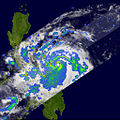File:TY Xangsane 20060926 TRMM.jpg

Size of this preview: 600 × 600 pixels. Other resolutions: 240 × 240 pixels | 480 × 480 pixels | 768 × 768 pixels | 1,024 × 1,024 pixels.
Original file (1,024 × 1,024 pixels, file size: 606 KB, MIME type: image/jpeg)
File history
Click on a date/time to view the file as it appeared at that time.
| Date/Time | Thumbnail | Dimensions | User | Comment | |
|---|---|---|---|---|---|
| current | 05:37, 8 October 2006 |  | 1,024 × 1,024 (606 KB) | Coredesat | {{Information |Description=NASA TRMM satellite image showing the well-defined eye of Typhoon Xangsane prior to its first landfall on Samar Island on September 26, 2006. |Source=[http://earthobservatory.nasa.gov/NaturalHazards/natural_hazards_v2.php3?img_i |
File usage
The following pages on the English Wikipedia use this file (pages on other projects are not listed):
Global file usage
The following other wikis use this file:
- Usage on pt.wikipedia.org


